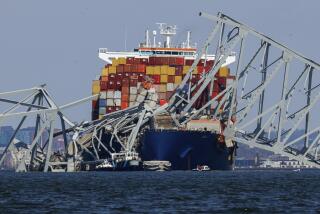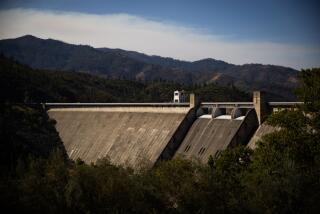New Town to Be Built Over One Buried in Dam Collapse : Dried Mud Only Memorial to 269 Italy Villagers
- Share via
STAVA, Italy — Two lone pines that somehow survived the catastrophe stand like silent mourners. Grass grows over the grave of Stava, a deserted plateau of dried mud that was once a bosky mountain village where winter skiers and summer hikers played.
Soon the village will live again. But until the reconstruction begins, the mud plateau is the only memorial to the 269 people whose lives ended abruptly in a mud slide here at 12:17 p.m. last July 19.
“We cannot let people forget them,” said Romano Pojer, director of the local bank and president of the association of survivors that is making plans to commemorate the anniversary of the tragedy and to rebuild the village. “People must never again die so terribly in this kind of preventable disaster.”
Stava was obliterated in a matter of seconds when an earthen dam holding back the waste water and silt of a fluorite mine just a few hundred yards above the village suddenly gave way.
‘Worse Than a Flood’
“It was worse than a flood, the worst possible kind of disaster,” said Mayor Adriano Iellici of Tesero, a neighboring town that was also damaged by the mud slide. “The silted-up contents of the dam just dumped on Stava like wet cement. The mud weighed 3 1/2 times more than water. The people were suddenly crushed by it, without warning.”
“Even heavy steel machinery was broken in pieces by the force of it,” said Fabio Biasi, a lawyer for the provincial government in nearby Trento, who has been assigned full-time to help the survivors sort out their lives and rebuild.
“Bodies of the victims were torn apart, so that many had to be identified by pieces of their arms and legs or by jewelry or dental work,” said Dr. Roberto Caliceti, the local veterinarian.
It took only a few seconds to bury virtually all of Stava’s houses and its three resort hotels. Then the 50-yard-wide wave of mud, water and debris roared down the two-mile-long valley, crushing another tourist hotel and more residences.
‘Like Hundred Helicopters’
“It sounded like a hundred helicopters taking off, and it was over in minutes,” Mayor Iellici said.
Locating the victims’ bodies in the days after the disaster was a nightmare. Hundreds of volunteers took part--soldiers, police and firemen from throughout the Trentino-Alto Adige region, in the spectacular Dolomite Alps of northeast Italy.
“We turned up thousands of cubic yards of mud,” Iellici said, “but we still don’t know if some people remain buried under it. In many cases all we found were bits of bodies, and in the end we buried 80 coffins containing unidentified remains in the Tesero cemetery.”
Memories of last July 19 are indelible for the 2,400 people of the Tesero Valley, which forms a part of Italy’s popular Latemar ski area. (Local boosters hope that the 1988 world ski championships will be held here.)
Married Local Girl
Few memories are more searing than those of Pojer, whose bank, the Casa Rurale di Tesero, serves the entire area. Pojer settled in the valley 15 years ago after he married a local girl, Andreana Deflorian, whose family owned and operated the Hotel Rio Stava, just under the steep wall of the dam. On most summer days, Andreana and Romano’s two sons, Carlo, 14, and Claudio, 13, were at the hotel helping her mother and father.
Pojer said: “I was working in the bank in Tesero (two miles down the valley from Stava and, politically, its parent town) when the wife of a colleague who lives up above the fluorite mine telephoned to say that a great white cloud was passing down the valley from Stava. I had heard nothing, and when I looked out in the piazza there was no sign of anything unusual.
“But when I looked up the road toward Stava, I saw that the earth had come over the bridge across the Stava River (a mountain stream that follows the valley.) I immediately telephoned Andreana at the hotel, and the phone rang but no one answered. I thought they had gone outside to see what happened.
‘Farm Wasn’t There’
“So I took my car and started up. I was among the first. When I got halfway, I realized that a whole farm that used to be beside the road wasn’t there any more. From there I could see the Stava Hollow, where all the hotels were.
“There were no hotels. They were gone. I couldn’t find a landmark. It was totally smooth. You couldn’t tell if it was shallow or 20 yards deep. It was as if the whole place had been deserted.
“Debris was floating on the mud, and I walked out on the debris. I don’t know how long I stood there. But it was long enough to know that no one was alive in there. My first thought was, “Why wasn’t I there also?’ ”
Andreana, Carlo, Claudio and seven other members of her family died.
“The only small comfort,” Pojer said, “is that it happened so quickly they didn’t know. When we found their bodies, it was obvious that they had been getting ready for lunch.”
Help in Reconstruction
The survivors’ organization that Pojer heads has applied continuing pressure on Italian government officials to help in the recovery and reconstruction and to prosecute those responsible for the condition of the dam.
So far, the valley’s emergency economic needs have been met with a state appropriation of $20 million for compensation and reconstruction, but the wheels of justice have turned slowly in assessing guilt.
Prosecutor Francesco Simeoni of Trento said that a team of geologists, hydrologists and other specialists has been examining the scene and its origins since five days after the dam collapsed and should have a report ready for him before the July 19 anniversary.
He said that the two brothers who own the now-abandoned mine, Giulio and Aldo Rota, have been arrested and that their papers concerning the dam have been impounded. Both are free on their own recognizance, he said, awaiting indictment and trial.
Used in Glassmaking
The fluorite taken from the mine is used in metallurgy and the making of glass, among other things, and Simeoni said the mine’s ownership has changed hands several times since the dam was built in 1960. He said his investigation includes former owners as well as the Rota brothers, in case the original responsibility for the hazardous earthwork lies in the past.
In addition, about 30 people, including public officials like Mayor Iellici, who may have been responsible for inspecting the dam and anticipating its collapse, have been interrogated, and some of them may be charged, Simeoni said.
“We want to see those responsible treated with maximum severity,” he said, and he forecast a trial date sometime in 1987. He said that once responsibility is fixed, about 80 civil damage suits are waiting to be filed.
Pojer and his group, meanwhile, are planning a memorial religious ceremony for July 19 under the two pine trees on the grass-covered field of mud that covers Stava. They have asked all the newspapers in Italy to run a black-bordered, full-page public service advertisement on that day, listing the names of all 269 people who died.
“We will not let people forget this too soon,” he said.
More to Read
Sign up for Essential California
The most important California stories and recommendations in your inbox every morning.
You may occasionally receive promotional content from the Los Angeles Times.













